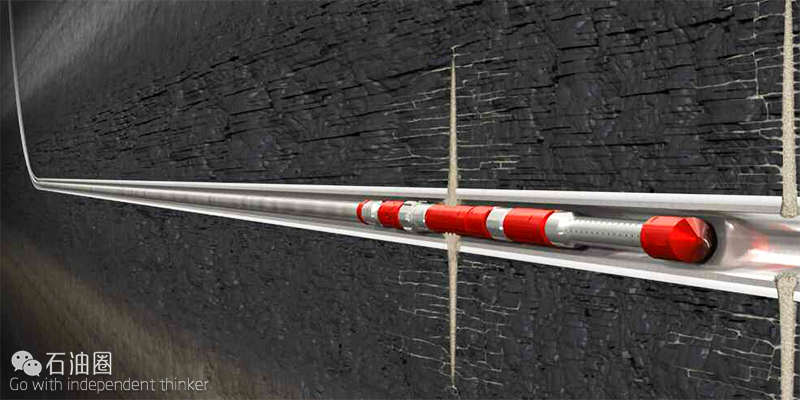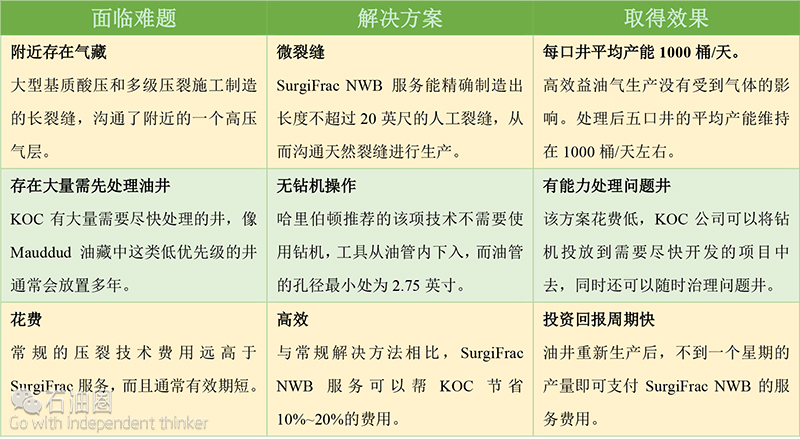SurgiFrac NWB Service
A Revolutionary Method to Stimulate Horizontal Openhole Wells
The SurgiFrac process uses the dynamic movement of the fluid to divert fluid flow into a specific point in the formation. The service is based on Halliburton’s patented method that combines hydrajetting and fracturing technologies.
SurgiFrac service requires a different approach to treatment design. Controlling and evaluating two primary fluid flows requires two separate pumping systems. The annulus must be pressurized at manageable flow rates. The design must include the number and types of fractures (small or large, sand or acid, etc.). In addition, the SurgiFrac service stimulation design must include the precise location of the fractures. Like conventional fracturing, a proper well candidate is critical to the success of the SurgiFrac service.
SurgiFrac service opens up new possibilities. For example, a well completed openhole may have hydrocarbon shows in multiple areas. With service it is theoretically possible to create large and small acid fracs in the lime areas and place large and small propped fractures in the sandstone/chert areas. A sand frac with acid could also be created to stimulate production from lenses.
In the SurgiFrac process, sand-laden fluid pumped through a Hydra-Jet tool impinges on the formation creating a cavity. As the cavity is formed, pressure on the bottom of the cavity increases, eventually initiating a fracture. Annular fluid is pulled into the fracture, helping to extend it.
New SurgiFrac service enables placing fractures with surgical precision. This is unprecedented control of fracture initiation and propagation can help operators achieve several important goals:
• Increase production from existing assets.
– Re-enter openhole horizontal wellbores in high perm or low perm formations with coiled tubing or jointed pipe and create fractures precisely in by passed and underperforming zones – quickly and cost effectively.
• Optimize reservoir drainage.
– Precise location of fractures means that treatments can be customized to meet well conditions.
• Add new production more quickly than with conventional fracturing.
– Multiple fractures can be created in the wellbore in only hours with no sealing (packers, etc.) required between zones.
• Reduce fracturing treatment costs.
– Low tortuosity inherent in the process can help cut costs by requiring less equipment and lower viscosity fluids.
SurgiFrac Service has been applied successfully in a variety of fracturing conditions
• Multiple propped fractures in openhole
• Multiple acid fractures in openhole
• Deviated casedhole
• Horizontal slotted liner
• Coiled tubing acid frac to bypass damage
• Multizone, multiple fractures in a cased vertical wellbore
Kuwait Oil Company (KOC) drilled the first horizontal wells targeting the Mauddud Reservoir more than 15 years ago. However, they did not produce for very long. Despite numerous attempts and experiments to restart production of the openhole completions, success proved elusive. Inherent characteristics of the formation, such as a high gas-oil ratio (GOR), make oil production a challenge. In a recent attempt at fracturing with acid that tapped into a high-pressure gas zone, the gas blocked production of the oil that KOC was targeting. After several attempts to solve the puzzle, KOC consulted Halliburton. Halliburton recommended using SurgiFrac NWB (near wellbore) service with the Hydra-Jet SPT tool to create carefully controlled fractures that stayed well within the oil. As of late 2014, Halliburton used this combination to fracture five wells. Sustained production from each well averaged approximately 1,000 BOPD. In each case, new production from the wells paid for the cost of SurgiFrac NWB service in less thna week
High pressure gas chokes off oil production
The Mauddud formation in Kuwait has low pressure and tight permeability. All attempts to restart production of the KOC wells through multistage fracturing and high-volume acidizing were short-lived. Wells might flow for a few weeks after the expensive treatments, but would quickly die again. Fractures propagated into an area containing high-pressure gas. Gas then broke through, choking off the flow of more valuable Mauddud oil.
Higher priorities and economics leave oil stranded in place
The challenging reservoir created even more complex completion challenges. The wells proved so difficult and expensive to produce that KOC decided to focus its workover activities on wells with higher economic potential. Despite large volumes of oil still in place, producing it turned out to be difficult and costly.
Halliburton suggests new approach using microfractures
Halliburton felt that the non-producing wells with openhole completions might make excellent candidates for its SurgiFrac NWB fracturing service. SurgiFrac NWB service uses concentrated, high-pressure fluid jets to create short, highly conductive hydraulic fractures. In this case, Halliburton felt that controlled microfracs could extend through the near-wellbore damage, through undamaged rock, and then connect to a well-developed complex of natural fractures. With careful modelling, Halliburton felt the induced fractures would stay within the Mauddud and not break through to nearby gas zones.
Geometry creates new challenges
Halliburton and KOC then engaged in discussions about deployment of the service. KOC decided not to invest in the cost of a rig to pull tubing. That meant Halliburton had to deploy its tools through 3.5 in. tubing that also had a 2.75 in. restriction. However, the hole itself – which was open – had an ID of 8.5 in.
Need to redesign the Hydra-Jet tool
Two of these three dimensions created huge challenges. First, none of Halliburton’s Hydra-Jet tools would fit through the 2.75 in. restriction. Second, the distance between the jets and the wellbore would decrease the energy that the tool could focus on rock, thus jeopardizing the mission.
Tool redesign solves restriction problem
To solve the first challenge, Halliburton went back to the drawing boards and completely redesigned a new generation of Hydra-Jet tools that could fit through the small restriction in the tubing.
Self-bending nozzle solves distance problem
To solve the second problem, Halliburton also created a special variant of the tool called the SPT (self-positioning tool). The SPT’s pressure stream bends the nozzle, decreasing the distance between the jets and wellbore (see illustration on page 3).
With the Hydra-Jet SPT nozzle touching the wellbore, models showed it could generate enough pressure to create 10 to 20 ft microfractures into the formation – exactly what KOC needed to connect the natural fractures yet avoid breaking through to the high-pressure gas zone. Halliburton used nickel when redesigning the tool because of H2S in the gas that had previously been encountered.
Low-cost approach: dynamic diversion
All of these changes meant the procedure could be performed in a safer manner by using a coiled-tubing unit instead of a rig, which also helped reduce costs significantly. Also, the Hydra-Jet SPT tool does not require the use of plugs or packers for diversion. It uses “dynamic diversion.” Dynamic diversion focuses fluid energy on a single point with enough energy to deeply penetrate rock and enlarge the tunnels it creates. Dynamic diversion also helps ensure that each target interval is treated discretely, receiving only the intended treatment volume and rate. The jetting velocity forces all fluid into the rock despite the 90°turn. Eliminating the need to set plugs or packers cut a two-to-three week job down to less than a day. Finally, because of the large width of the fractures created, no proppant was necessary to hold them open. This saved additional costs.
The “acid test” proves successful
After addressing all the technical challenges, KOC and Halliburton decided to try the technique on one well. The test was a resounding success. Wellhead pressure went from zero to 500 psi. KOC targeted a production rate of 500 BOPD, but initial production tripled that; it soared to 1,500 BOPD. Sustained production doubled their target; it leveled out at around 1,000 BOPD – for three years, not just two or three weeks.
One success leads to another – from zero to 1,000 BOPD in five wells
KOC then decided to try the technique on a second well. It too yielded sustained production of around 1,000 BOPD, this time for six months. Since then, three additional wells have been treated. They too are averaging 1,000 BOPD of sustained production – and are still producing. In each well, renewed production paid for the cost of the operation in less than a week.
Potential elsewhere
Halliburton’s SurgiFrac service may be beneficial in providing a cost-effective solution for other wells with similar circumstances throughout the Mauddud Reservoir, which extends into neighboring countries.


 石油圈
石油圈

